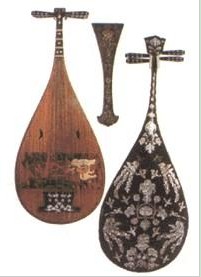Pipa
Pipa (琵琶) is the oldest and most famous plucked instrument in China. It's a four-stringed lute with 30 frets and pear-shaped body. The instrumentalist holds the pipa upright and play with five small plectra attached to each finger of the right hand.
Originally named after the loquat fruit, the earliest pipa known was found to have been made in the Qin Dynasty (221 – 206 BC). There were two kinds. One was "Qin pipa," which had a straight handle and round sound box, and animal skin covered the two sides. It could be plucked and strummed with the fingers. The other, "Han pipa" or ruanxian, was vertically plucked with a plectrum. Approximately in the mid-fourth century, a pipa with a crooked neck spread to China from India. Later on, the Chinese musicians integrated the performing skill of Han pipa with those of the Indian one, and the present pipa gradually took shape.
By the Tang Dynasty (618 - 907), pipa had reached its summit. It was loved by all -- from the royal court to the common folk, and was mentioned in the works of many writers and poets such as Bai Juyi, the master poet.
Afterward, pipa underwent improvement in playing techniques and structure. Players changed from holding the pipa transversely to holding it vertically, and from using a pick to using the fingers to pluck the strings directly. In modern times, the volume and resonance has also been improved.
Among all pipa repertoire, Shi mian mai fu (Ambush on All Sides) has the widest popularity. As one of the five representative works of pipa music, it depicts the story of the ambush masterminded by Liu Bang to defeat Xiang Yu when the states of Chu and Han confronted each other. By using the special fingerings of the pipa, the music vividly depicts a fierce battle scene. It begins with Liu Bang discussing military affairs in his tent, then calling the roll of officers and assigning them operations, deploying the troops in battle formation, and setting up the ambush.
